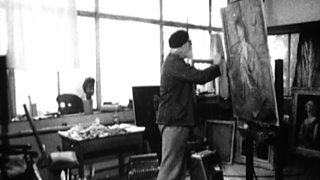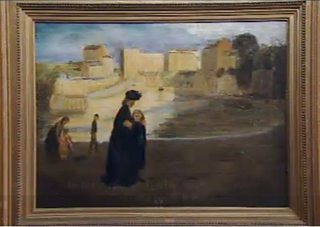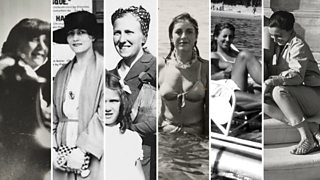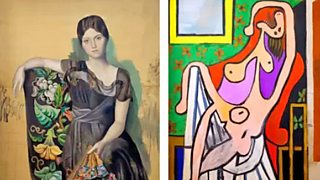Sophisticated, radical and international: The Story of Welsh Art
27 February 2023
Welsh art has suffered from an image problem. This is the starting premise for broadcaster Huw Stephens' series The Story of Welsh Art. Over three programmes, the presenter reveals a cultural treasure trove that is sophisticated, radical and international. These are ten of the surprises in store - the box-set is streaming now on iPlayer.
1. Modern landscape painting was invented in Wales
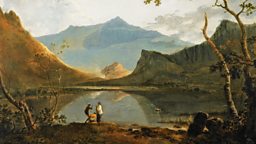
of Penegoes near Machynleth, revolutionised art. Not only in Wales, but the whole of Britain.
Wilson is the greatest Welsh artist of all time, and a major international figure.Art Historian Robin Simon
"He's not just a national genius, easily the greatest Welsh artist of all time, he's a major international figure," asserts Art Historian Robin Simon. He became a hero and inspiration to great artists such as Turner and Constable.
As a master of the '', Wilson took the traditional form of the fictional idealised landscape and reimagined what it could be. He blended it with the topographical to produce what Robin refers to as "a kind of landscape that is true to nature, and yet wonderfully evocative and suggestive of an ideal landscape."
turned his eye to the Welsh mountains, and when those paintings were exhibited in London a stunned audience embraced the hitherto unrealised beauty possessed by these landscapes.
2. English artist Turner shaped the way we see Wales

first visited Wales when he was 17, going on to make five tours of the country and filling up hundreds of sketchbooks.
Even now, we still see Wales through Turner's eyes.
What he captured in his work, Huw Stephens reveals, was the "wild, untamed vision of the rugged coastline and high Welsh mountains."
Curator James Finch points to Turner "learning the language of topographical landscape" in Wales, something that would underpin his work for years to come.
Renowned for the drama in his art, even in early work c1794, Huw compares the painting to the actual location commenting, "Turner's main priority wasn't accuracy," emphasising that "it was sensation, not scenery, that drove him."
It remains that, "Even now, we still see Wales through Turner's eyes."
3. The first use of written Welsh is in a book thought to help women get pregnant

A masterpiece of medieval Christian art, the St Chad Gospels is an illuminated manuscript featuring the Gospels of Matthew, Mark and part of Luke. Dating from the mid-8th century, it is a work of unprecedented beauty and intricacy.
Although housed today in, the book was initially recorded in Wales in the mid-9th century and it is there that it can make its claim to a number of firsts, as Professor Michelle Brown explains:
"It seems to have been used as an oath book in Wales...This is when the first additions to the manuscript are made, and it includes the earliest examples to survive to us of Welsh handwriting, and of the written Welsh language."
Not only that, it also seems to have functioned as a guarantee of fertility, containing women's names etched almost imperceptibly into its margins.

4. The first painting of a named Welshman was in the 15th century

Christian art dominated for centuries in Wales, but a shift was coming and this was highlighted by a painting commissioned by a Welsh nobleman, Sir John Donne of Kidwelly. Art could now be a celebration of man, not only of God.
Anyone who saw this knew it was painted for a very important individual, from the best painter of the dayEmma Capron, National Gallery
Donne wanted to show off his status in the York royal court and is recognised as the "first painting of a named Welsh person." As Emma Capron of the National Gallery, where the painting is now housed, points out, "one with great taste," and painted in Bruges by the greatest artist of his day, .
Emma notes, "It's painted with such dexterity, there is a realism and presence. It was probably painted from life," and "anyone who saw this knew it was painted for a very important individual, from the best painter of the day." It represented an introduction to the - "in the British Isles no-one had seen anything like it."
5. Thomas Jones painted urban images perfect for Instagram - in the 18th century

"It's been said we know more about than any other 18th century Welshman," due to the which Jones kept while a pupil of Richard Wilson in London. However, as Huw goes on to explain "until recently his groundbreaking art was relatively unknown."
When they became known in the 1950s, these urban paintings of Naples would earn Jones a place in history.
In 1776, Jones travelled from his Pencerrig estate in Wales, through Italy to Naples where he painted over 50 scenes of everyday life. When they became known in the 1950s, these paintings would earn Jones a place in history.
The flat, geometric quality of the scenes he captured from his window established him as "an artist who was ahead of his time," according to Art historian Mari Griffith, with "a style we see in the work of the in the late 19th century. In the late 18th century it was very, very unusual." The cropped urban images by Jones wouldn't seem out of place on Instagram today.
6. Wales has art older than the Egyptian pyramids

(‘The Giantess’s Apronful’) is a and one of only two sites in Wales incorporating rock art. The site contains a number of decorated stones covered in beautiful spirals and zig-zag patterns, which were created 5000 years ago.
These stones might then carry the earliest depiction of a landscape in all of Britain.Huw Stephens
According to archaeologist George Nash, "we have these zig-zag lines, which are very unusual indeed... what we’ve got here is bringing the wider outside landscape, which is very dramatic, inside the monument.
So the little circle could represent a celestial body such as the moon or the sun, and those zig-zag lines could represent the Snowdonia range.”
According to presenter Huw Stephens, “These stones might then carry the earliest depiction of a landscape in all of Britain.”
7. This 17th century public display of affection would have shocked viewers
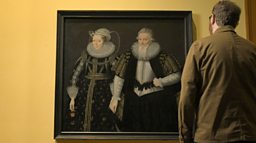
In 1603 the Welsh nobleman Sir Thomas Mansel of Margam House married Jane Pole. For the occasion, Mansel commissioned a , committing an almost unheard of public display of affection to canvas.
The delicate vision of the nearly monochromatic bride and groom are captured holding hands, an intimate and touching display of their love.
Sir Thomas and Jane were not the only Mansel patrons of progressive art. In 1690 their descendants commissioned two views of Margam House and its lands.
As Huw discovered, "It was the first time a Welsh home had been the subject of a painting," and with a drone's eye overview the unknown artist captured a viewpoint rarely seen in art at that time.

8. Industrial works were painted like cathedrals

The landscape of Wales changing, as by 1850 the country was a leader in the industrial revolution.
The wealthy Crawshay family owned the in Cyfarthfa, near Merthyr Tydfil.
In 1825, ‘Iron King’ William Crawshay commissioned artist Penry Williams to capture "the beauty of industry" and Penry produced a watercolour interior view of the iron works, full of drama and backlit by fire highlighting its cathedral-like rafters.
Expert Benjamin Price underlines that not only did Williams’ work encapsulate the "elegance" and "pride" in the changing environment, but he captures "documentary evidence of the toil and hardship" of the common man, making industrial workers visible in art.
Some years later, Crawshay’s son Francis commissioned the painting of named by artist William Jones Chapman, something which Dr Melanie Polledri of the National Museum Wales suggests makes them "very special" and "the only ones that identify individual workers...in the whole of Britain."
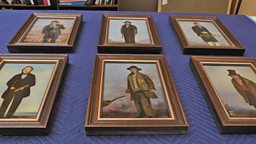
9. Britain's first artist colony was in North Wales
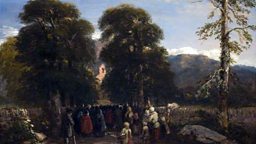
As the 19th century progressed, industrial pollution increased. Some artists sought out places that promised peace and purity. One such place was Betws-y-Coed, a small picturesque village in the Conwy Valley.
In the 1840s , "a celebrated landscape painter from Birmingham, ranked second only to Turner” was employed to illustrate a guide book. He was drawn to the village’s "remote scenic beauty." The success of that guide book attracted tourists and other artists, and Cox would return there to paint each summer.
Betws-y-Coed was on the map, and Cox had inadvertently founded . His painting, The Welsh Funeral (1848) would immortalise St Michael’s, the local church, and become “the defining image of Wales in Victorian art.”
Though Cox was its founder, other groundbreaking artists including settled in the village, until eventually in the 1880s the tourists who were drawn there led to most resident artists decamping further up the valley. Its lasting legacy would be the creation of the which still exists today.
10. Artist Gwen John was a model and muse for Rodin
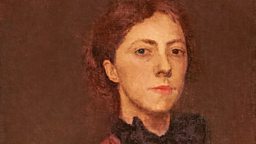
Gwen was the sister of , the leading portrait artist of his day and they were brought up in the seaside town of Tenby in South Wales.
Gwen’s Biographer Alicia Foster recounts that when “Gwen John struck out on her own, she decided to forge her own artistic path and that takes her to Paris, which is where all young modernists wanted to go in the late 19th early 20th century."
There, Huw tells us, “she met the world famous sculptor Rodin, and became his lover and model.” Alicia explains this is emblematic of her bold character, “To go to Paris in 1904 and take your clothes off in the studio of the most famous sculptor in the world...that isn’t someone who is reticent or lacks self belief, or is shy about the world.”
This confidence was expressed in her own artistic work, which was discussed by eminent artists. “My sister has a fine appreciation of character” said Augustus John to who apparently replied, “No, it’s tone your sister understands, it’s tone.”
Ultimately, Alicia contends, Gwen is "Without doubt one of the greatest British artists of the 20th century, and one of the greatest Welsh artists."
Gwen and Augustus on the 成人快手
-
![]()
Augustus and Gwen: The Fire and the Fountain
The story of the artist siblings Augustus and Gwen John
-
![]()
Framing Wales
Augustus and Gwen John in Tenby
-
![]()
Gwen John: Bitesize
Curator Karen McKinnon shows presenter Kim Howells a typical example of Gwen John's work
The three part box-set The Story of Welsh Art is streaming now on 成人快手 iPlayer.
More from 成人快手 Arts
-
![]()
Picasso鈥檚 ex-factor
Who are the six women who shaped his life and work?
-
![]()
Quiz: Picasso or pixel?
Can you separate the AI fakes from genuine paintings by Pablo Picasso?
-
![]()
Frida: Fiery, fierce and passionate
The extraordinary life of Mexican artist Frida Kahlo, in her own words
-
![]()
Proms 2023: The best bits
From Yuja Wang to Northern Soul, handpicked stand-out moments from this year's Proms
